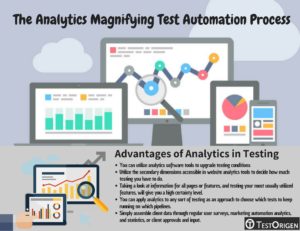
The manner in which associations develop software has changed essentially over the last couple of years. From agile to DevOps to continuous everything, developers are running quicker and developing more substance in less time.
As a tester, you must keep up. You should empower the business to run speedier and decrease time-to-market, however without harming the quality of the product, which would negatively affect the value of your image.
Clients expect quick updates, fixes, and feature improvements to products that they utilize and love. And, you have to accomplish the majority of this while decreasing expenses. So how would you use analytics software in automation testing to strike the right balance?
We could state that automated software testing is basically a quality control framework that vets the operational parts of a product. The point is to make a testing procedure that is thorough and that works through one or various test automation systems. Regularly, upon completion, the automation testing tools report the outcomes and compare results and past testing cycles.
This is the time of big data technologies and analytics software – it makes sense that innovators have created BI analytics solutions that offer bits of knowledge intended to make an interpretation of these test results into actionable data for a future change.
These business intelligence software solutions proactively find issue regions in the testing procedure and demonstrate the path forward to accomplish a high-quality product. We should investigate how analytics software can help test automation.

Utilization of Analytics:
Data and analytics offer a logical solution to the issue of deciding how to decrease the extent of regression tests while mitigating risk. Big data analytics empowers programming engineers to basically assess the performance of their automated software application. They can track the different measurements and parameters associated with the development of test automation and the performance of the automated software testing tools. Bug logs implanted in the Google analytics dashboard can spotlight the territories of improvement. So also, information about the number and the sort of functions that pass summon demonstrate the health of the product that is being tested. The last status of the test outcomes displays an ideal picture of the condition of functionalities of the tested product. The graphical representation in the Google analytics report depicts a reasonable picture of the testing results that are easy to understand and read for everybody.

Advantages of Analytics in Testing:
-
Utilize analytics tools:
You can utilize analytics software tools, for example, Google Analytics, to accumulate data about your software product that you can use to upgrade testing conditions. Analytics can help pinpoint the highest-risk areas of your software product for regression testing and approve your underlying presumptions and worries about your product.
-
Deep jump into your software product:
Add secondary dimensions in automated analytics to understand the ideal combinations that reflect what clients are utilizing in production. Utilize the secondary dimensions accessible in website analytics tools to decide how much testing you have to do, and where, so as to pick up the certainty and scope levels you require.
-
Focus on user behaviors:
Study user behaviors to locate the most dynamic regions of the site and to pinpoint how clients routinely connect with your software. Taking a look at information for all pages or features, and testing your most usually utilized features, will give you a high certainty level.
-
Apply web analytics automation testing framework all over the place:
Whenever developers and testers hear the word business analytics, they may think about automation. However, you can apply analytics to any sort of testing as an approach to choose which tests to keep running on which pipelines.
-
Consider different data analysis software and analytics tools:
Information is accessible all over the place, and you can utilize it to find out about the zones of your product you didn’t test in regression. These extra information focuses can likewise help inform your future testing strategy.
-
No google analytics web? No problem:
It’s alright if you are working on a product that does not utilize web analytics software to collect information about your clients. Simply assemble client data through regular user surveys, marketing automation analytics, and statistics, or client approvals and input.
These six benefits accomplish more than help in magnifying the test automation process; they can crumple a comprehensive test technique into a “simple enough” test methodology that finds the most vital issues rapidly while decreasing test attempts by up to approx 80%.

Drive your testing with analytics:
The challenge of software testing lies in discovering issues that your clients believe are imperative as ahead of schedule as could be allowed. Thorough test approaches, if you can do them at all, are costly and give a lot of data, some of which may not be important. It “does everything” approach likewise tends to software delivery dates out.
So, embrace the Analytics and search for chances to change your test automation methods.
